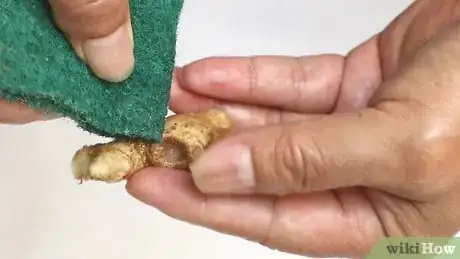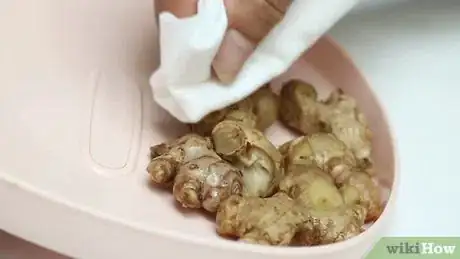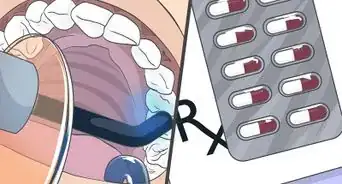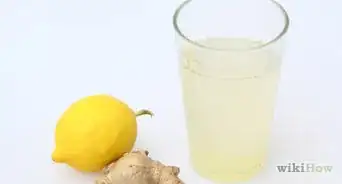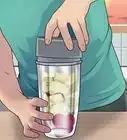This article was co-authored by wikiHow Staff. Our trained team of editors and researchers validate articles for accuracy and comprehensiveness. wikiHow's Content Management Team carefully monitors the work from our editorial staff to ensure that each article is backed by trusted research and meets our high quality standards.
There are 11 references cited in this article, which can be found at the bottom of the page.
The wikiHow Video Team also followed the article's instructions and verified that they work.
This article has been viewed 87,023 times.
Learn more...
Ginger juice offers a host of health benefits, and it can add a flavorful punch to foods and beverages. Using a juicer is the most efficient method, but they can get pricey, and you may not have one handy. If you don’t have a juicer or blender, simply strain grated ginger root through a sheet of cheesecloth. Alternatively, blend chunks of ginger with water, then strain the pulp. Since fresh ginger juice doesn’t last long, use the amount you need immediately, then freeze the rest for up to 6 months.
Steps
Extracting Ginger Juice with a Grater
-
1Wash and dry your ginger root before juicing it. Rinse the ginger thoroughly under cold running water. Scrub the surface with your fingertips, or use a vegetable scrubbing brush to remove stubborn dirt. After washing it, pat the ginger dry with a paper towel or clean cloth.[1]
- For another effective washing method, soak ginger or other produce in a bowl of cold water mixed with 1 teaspoon (6 grams) of baking soda for 15 minutes.[2]
- The right amount of ginger root depends on how much juice you need. If you only need 1 or 2 teaspoons (4.9 or 9.9 mL) of juice, wash and cut off a 1 to 2 in (2.5 to 5.1 cm) piece of root. For a larger amount, 8 to 10 oz (230 to 280 g) of ginger will yield about 1⁄2 to 3⁄4 c (120 to 180 mL) of juice, depending on the method you use.[3]
- If your ginger root is shriveled or blemished, peel it and cut off any bruises. If it’s fresh and blemish-free, there’s no need to peel it.[4]
-
2Grate the ginger with a fine grater or a microplane. Use a box grater’s smallest holes, or run the ginger root over a microplane. Place a bowl beneath the grater or microplane the collect the bits of ginger.[5]
- A microplane is a narrow handheld grater with fine holes. It’s usually used to zest citrus, but it’s also great for mincing ginger.
- If you don’t have a grater or microplane handy, you could also grate the ginger using a garlic press. Place a 1⁄2 in (1.3 cm) piece of ginger root into the press, then squeeze together the handles to mince the ginger.[6]
Advertisement -
3Strain the grated ginger through cheesecloth. Dump the bowl of grated ginger into a 24 in (61 cm) by 24 in (61 cm) sheet of cheesecloth. Fold the cheesecloth into a ball, hold it over a bowl or cup, and squeeze it to extract the juice from the grated ginger.[7]
- Keep squeezing the cheesecloth ball until the grated ginger is as dry as possible.
- Straining grated ginger is easy and doesn’t require expensive equipment, such as a blender or juicer. However, it’s less efficient, and you’ll extract less juice than other methods.
Making Ginger Juice with a Blender
-
1Wash and dry 5 oz (140 g) of ginger root. Rinse your ginger under cold water, and scrub any dirt off of the surface. Then dry it with a paper towel or clean cloth.[8]
- The right amount of ginger root depends on how much juice you need. For this method, you’ll blend 5 oz (140 g) of ginger with water to create about 1 to 1 1⁄2 c (240 to 350 mL) of juice. If you just need a bit of juice, blend a 1 to 2 in (2.5 to 5.1 cm) piece of ginger root with 2 to 3 tablespoons (30 to 45 mL) of water.[9]
-
2Cut the ginger into 1⁄2 in (1.3 cm) chunks. Grab a cutting board and roughly chop the ginger root. Smaller chunks will be easier on your blender.[10]
- Leave your ginger root unpeeled, as long as it’s fresh and free of any bruises or discoloration. Otherwise, peel it and cut off any blemishes.
-
3Blend the ginger with 1⁄2 to 1 c (120 to 240 mL) of water. Place the ginger chunks in your blender, then pour in the water. Blend the ginger and water for 1 to 2 minutes, or until it becomes a pasty pulp.[11]
- You need to blend the ginger with water; however, the more water you use, the less concentrated your juice will be. Start with 1⁄2 c (120 mL) and add more if the ginger doesn't become pulpy.
- To draw even more flavor out of the ginger root, blend it with a mixture of 1 part 40-proof alcohol and 4 parts water. If you’re worried about the alcohol content of the final product, you can simmer the juice for 1 to 2 hours to evaporate most of the alcohol.[12]
-
4Strain the ginger pulp through cheesecloth. Cover the rim of a jug or bowl with cheesecloth, leaving some slack in the cloth to collect the solid ginger bits. Pour the pulp into the jug or bowl, then squeeze the ginger you collected in the cheesecloth until it’s as dry as possible.[13]
- Since you added water to blend the ginger, the juice will be less concentrated, but it’s still flavorful.
- Alternatively, simmer the juice to evaporate water if you need a stronger ginger flavor.
-
5Reduce the liquid to concentrate the flavor. For more concentrated ginger juice, bring it just to a boil in a saucepan over medium heat. Then set the heat to low and simmer the juice until it’s decreased in volume by 1/3 to 1/2, or for about an hour. If you added alcohol to the water, simmering for 1 to 2 hours will also evaporate most of the alcohol content.
- A liquid is simmering when pockets of small bubbles erupt to the surface every 1 to 2 seconds. If you see continuous, rolling bubbles, the liquid is boiling, and you should reduce the heat.
Using a Juicer
-
1Wash 8 oz (230 g) of ginger root and pat it dry. Scrub your ginger under cold running water with your fingertips or a vegetable scrubbing brush. Dry it off with paper towels or a clean cloth after rinsing it.[14]
- If you’re using a juicer, 8 oz (230 g) of ginger root will yield about 3⁄4 c (180 mL) of concentrated ginger juice.
-
2Cut the ginger into 1⁄2 to 1 in (13 to 25 mm) chunks. Leave the ginger unpeeled, unless it’s shriveled or blemished. Roughly chop it into smaller pieces, which you’ll insert into the juicer's feed tube.[15]
- If necessary, cut off and discard any blemishes.
-
3Feed the chunks of ginger into the juicer. Place a cup or bowl under the juicer’s spout. Turn on the juicer’s motor, insert the chunks of ginger root into the feed tube, and gently push the ginger through the tube with the plunger. Instructions vary by model, so check your juicer’s manual and use it as directed.[16]
- After juicing the ginger root, turn off the juicer and unplug it. Follow the instructions in the user manual to disassemble and clean it.
-
4Juice ginger before other items if you're making a mixed juice. If you want to add ginger to an existing juice recipe, start by feeding a 1 to 2 in (2.5 to 5.1 cm) piece of ginger into the tube. Then juice ingredients with high water content, such as celery, spinach, pears, or carrots.[17]
- Fruits and veggies that contain lots of water will wash out the juicer and help you extract as much ginger juice and flavor as possible.
- Ginger can add a kick to just about any combination of ingredients. Try juicing a piece of ginger, 3 pears, and 2 celery sticks. Or, juice a piece of ginger, 2 stalks of fennel, half of a cucumber, half of a green apple, and a handful of mint leaves.
References
- ↑ https://www.fda.gov/food/resourcesforyou/consumers/ucm110526.htm
- ↑ https://www.ncbi.nlm.nih.gov/pmc/articles/PMC5071777/
- ↑ https://www.101cookbooks.com/archives/a-lesson-in-juicing-recipe.html
- ↑ https://www.dailymail.co.uk/health/article-94756/How-juicing.html
- ↑ https://food.ndtv.com/food-drinks/7-miraculous-benefits-of-ginger-juice-from-better-digestion-to-beautiful-hair-1685835
- ↑ https://www.today.com/food/best-13-garlic-press-peeler-review-t122075
- ↑ https://www.foodandwine.com/recipes/fresh-ginger-juice
- ↑ https://www.fda.gov/food/resourcesforyou/consumers/ucm110526.htm
- ↑ https://www.101cookbooks.com/archives/a-lesson-in-juicing-recipe.html
- ↑ https://www.allrecipes.com/recipe/229320/malian-ginger-juice/
- ↑ https://www.allrecipes.com/recipe/229320/malian-ginger-juice/
- ↑ https://www.ars.usda.gov/ARSUserFiles/80400525/Data/retn/retn06.pdf
- ↑ https://www.allrecipes.com/recipe/229320/malian-ginger-juice/
- ↑ https://www.fda.gov/food/resourcesforyou/consumers/ucm110526.htm
- ↑ https://www.dailymail.co.uk/health/article-94756/How-juicing.html
- ↑ http://www.pbs.org/wnet/need-to-know/health/juicing/10814/
- ↑ https://drinks.seriouseats.com/2013/08/how-to-make-delicious-juice-at-home-juicing-tips-juicers-fruit-vegetable-combinations.html
- ↑ https://food.ndtv.com/food-drinks/7-miraculous-benefits-of-ginger-juice-from-better-digestion-to-beautiful-hair-1685835
About This Article
To extract ginger juice at home without a juicer, try using either a grater or a blender. First, wash and dry your ginger to get rid of any dirt. Then, begin grating the ginger on the smallest holes of the grater. Make sure to place a bowl beneath to catch the ginger bits. Once you’ve grated all the ginger, dump it into a cheesecloth. Then, squeeze the cheesecloth over a bowl until you’ve gotten as much juice out as possible. To extract ginger juice with a blender, cut your clean ginger into ½ inch chunks. Then, blend the chunks with ½ to 1 cup of water for 2 minutes. Cover the rim of a bowl with a sheet of cheesecloth, and pour the ginger liquid on top. Finally, squeeze out the liquid from the cheesecloth. To learn how to use a juicer, read on!

